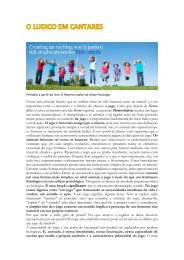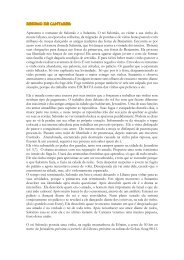Motherhood in Childhood
You also want an ePaper? Increase the reach of your titles
YUMPU automatically turns print PDFs into web optimized ePapers that Google loves.
ADOLESCENT ABORTION RATES DROP BY<br />
TWO-THIRDS IN UKRAINE<br />
One million abortions were reported each year <strong>in</strong> Ukra<strong>in</strong>e <strong>in</strong> the<br />
early 1990s. S<strong>in</strong>ce then, the number has decreased by more than 80<br />
per cent, ma<strong>in</strong>ly because of <strong>in</strong>creased access to contraceptives and<br />
family plann<strong>in</strong>g <strong>in</strong>formation and services.<br />
The abortion rate among adolescents between the ages of 15<br />
and 17 has also decl<strong>in</strong>ed, from 7.74 abortions per 1,000 girls, to 2.51<br />
today. This decrease is attributed to Government efforts to <strong>in</strong>crease<br />
access to youth-friendly health services and to legislation, policies<br />
and programmes that prioritize young people’s sexual and reproductive<br />
health.<br />
One such programme, the Government’s “Reproductive Health<br />
of the Nation,” aims to preserve the reproductive health of the<br />
population and positively <strong>in</strong>fluence reproductive health among<br />
adolescents. Another, the national Youth of Ukra<strong>in</strong>e programme<br />
promotes healthy lifestyles as a national priority.<br />
UNFPA, the World Health Organization and UNICEF are support<strong>in</strong>g<br />
the M<strong>in</strong>istry of Health’s development of a comprehensive<br />
regulatory and <strong>in</strong>stitutional framework for youth-friendly health<br />
services.<br />
Access to quality family plann<strong>in</strong>g services, <strong>in</strong>clud<strong>in</strong>g counsell<strong>in</strong>g<br />
on modern methods of contraception, has improved, and awareness<br />
about the health benefits of family plann<strong>in</strong>g has grown. The<br />
Government has entered <strong>in</strong>to partnerships with pharmaceutical<br />
companies and pharmacies to broaden the range of available contraceptives<br />
and reduce their price, and the M<strong>in</strong>istry of Health has<br />
strengthened its capacity to support and promote family plann<strong>in</strong>g<br />
<strong>in</strong>itiatives, <strong>in</strong>clud<strong>in</strong>g those available to adolescents and youth.<br />
Viktoriya Verenych, an obstetrician-gynaecologist at a youthfriendly<br />
cl<strong>in</strong>ic <strong>in</strong> Kyiv, says that over the past five years, she has<br />
noticed a trend of earlier sexual debut among her clients.<br />
“It is very important that at this po<strong>in</strong>t <strong>in</strong> their lives, they have<br />
access to qualified counsell<strong>in</strong>g on prevention of unwanted pregnancies,<br />
HIV and sexually transmitted <strong>in</strong>fections,” Verenych says. “This<br />
counsell<strong>in</strong>g must be provided <strong>in</strong> a youth-friendly manner.”<br />
60 per cent more likely to report the current use<br />
of a modern contraceptive compared to similar<br />
youth not exposed to the programme. Likewise,<br />
attitudes towards child marriage changed. At the<br />
start of the programme, 66 per cent of boys and<br />
60 per cent of girls believed that the ideal age of<br />
marriage for girls was 18 or older. After the programme,<br />
the comparable figures were 94 per cent<br />
of boys and 87 per cent of girls (Kanesathasan et<br />
al., 2008).<br />
Access to emergency contraception is especially<br />
important for adolescents, especially girls, who<br />
often lack the skills or the power to negotiate<br />
use of condoms and are vulnerable to sexual<br />
coercion, exploitation and violence. Emergency<br />
contraception is a method to prevent pregnancy<br />
with<strong>in</strong> five days of unprotected <strong>in</strong>tercourse,<br />
failure or misuse of a contraceptive (such as a<br />
forgotten pill), rape or coerced sex. It disrupts<br />
ovulation and reduces the likelihood of pregnancy<br />
by up to 90 per cent. It cannot prevent<br />
implantation of a fertilized egg, harm a develop<strong>in</strong>g<br />
embryo or end a pregnancy.<br />
Barriers to adolescents’ access<strong>in</strong>g emergency<br />
contraception <strong>in</strong>clude lack of knowledge about<br />
it, reluctance of health care workers to provide<br />
it, cost, community opposition to its use and<br />
legal restrictions.<br />
In 22 countries, a dedicated and registered<br />
emergency contraceptive pill is unavailable<br />
(International Consortium for Emergency<br />
Contraception, 2013). Even <strong>in</strong> countries where<br />
emergency contraception is available, adolescents<br />
may be reluctant to obta<strong>in</strong> it from traditional<br />
health outlets, such as cl<strong>in</strong>ics, which may be<br />
staffed by judgmental providers. To make it<br />
easier for adolescents to obta<strong>in</strong> emergency contraception,<br />
the non-governmental organization<br />
PATH developed a project <strong>in</strong> Cambodia, Kenya,<br />
72 CHAPTER 4: TAKING ACTION

















